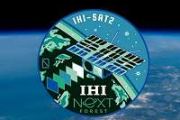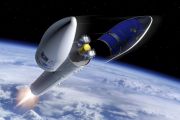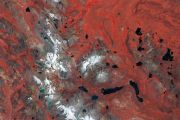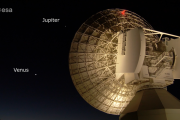
Copernical Team
Rain may have helped form the first cells, kick-starting life as we know it
 Billions of years of evolution have made modern cells incredibly complex. Inside cells are small compartments called organelles that perform specific functions essential for the cell's survival and operation. For instance, the nucleus stores genetic material, and mitochondria produce energy.
Another essential part of a cell is the membrane that encloses it. Proteins embedded on the surface
Billions of years of evolution have made modern cells incredibly complex. Inside cells are small compartments called organelles that perform specific functions essential for the cell's survival and operation. For instance, the nucleus stores genetic material, and mitochondria produce energy.
Another essential part of a cell is the membrane that encloses it. Proteins embedded on the surface China's underground lab seeks answer to deep scientific riddle
 Far beneath the lush landscape of southern China, a sprawling subterranean laboratory aims to be the world's first to crack a deep scientific enigma.
China has emerged as a science powerhouse in recent years, with the country's Communist leadership ploughing billions of dollars into advanced research to contend with the United States and other rivals.
Its latest showpiece is the Jiangmen
Far beneath the lush landscape of southern China, a sprawling subterranean laboratory aims to be the world's first to crack a deep scientific enigma.
China has emerged as a science powerhouse in recent years, with the country's Communist leadership ploughing billions of dollars into advanced research to contend with the United States and other rivals.
Its latest showpiece is the Jiangmen Astroport and Orbit Fab Team Up to Drive Lunar Exploration Efforts
 Astroport Space Technologies, Inc., a leader in space exploration technologies, and Orbit Fab, Inc., a specialist in in-space refueling, have announced a strategic partnership aimed at accelerating the development of lunar infrastructure to support sustainable space exploration. The announcement took place at the 75th International Aeronautical Congress (IAC), attended by over 8,000 experts and
Astroport Space Technologies, Inc., a leader in space exploration technologies, and Orbit Fab, Inc., a specialist in in-space refueling, have announced a strategic partnership aimed at accelerating the development of lunar infrastructure to support sustainable space exploration. The announcement took place at the 75th International Aeronautical Congress (IAC), attended by over 8,000 experts and Goonhilly Expands Deep Space Communications Services
 Goonhilly Earth Station Ltd (Goonhilly) has secured a new contract to provide deep space communications services for the UK Space Agency and international partners from its Cornwall-based Earth station. The agreement, announced at the International Astronautical Congress in Milan on October 16, aims to enhance the global network used for space mission communications as the demand for lunar and d
Goonhilly Earth Station Ltd (Goonhilly) has secured a new contract to provide deep space communications services for the UK Space Agency and international partners from its Cornwall-based Earth station. The agreement, announced at the International Astronautical Congress in Milan on October 16, aims to enhance the global network used for space mission communications as the demand for lunar and d Hubble captures dramatic eruption of stellar duo
 NASA's Hubble Space Telescope has unveiled a vivid and captivating close-up of R Aquarii, a binary star system located about 700 light-years from Earth. The system's chaotic eruptions create vast spirals of glowing gas, resembling a frenzied lawn sprinkler, and showcase the universe's process of recycling nuclear material expelled by stars.
R Aquarii belongs to a category of double stars k
NASA's Hubble Space Telescope has unveiled a vivid and captivating close-up of R Aquarii, a binary star system located about 700 light-years from Earth. The system's chaotic eruptions create vast spirals of glowing gas, resembling a frenzied lawn sprinkler, and showcase the universe's process of recycling nuclear material expelled by stars.
R Aquarii belongs to a category of double stars k It's twins mystery of famed brown dwarf solved
 An enduring mystery surrounding the first discovered brown dwarf, Gliese 229B, has finally been unraveled by astronomers from Caltech. Despite having been studied extensively since its discovery in 1995, the brown dwarf's faintness for its estimated mass of 70 times that of Jupiter left researchers puzzled. However, recent findings have revealed that Gliese 229B is actually a closely orbiting pa
An enduring mystery surrounding the first discovered brown dwarf, Gliese 229B, has finally been unraveled by astronomers from Caltech. Despite having been studied extensively since its discovery in 1995, the brown dwarf's faintness for its estimated mass of 70 times that of Jupiter left researchers puzzled. However, recent findings have revealed that Gliese 229B is actually a closely orbiting pa NJIT secures $5M NASA grant to create AI-based solar eruption research center
 NJIT's Institute for Space Weather Sciences (ISWS) has received a $5 million grant from NASA to establish a new research center focused on advancing solar eruption prediction using artificial intelligence.
The AI-Powered Solar Eruption Center of Excellence in Research and Education (SEC) will collaborate with NASA, New York University, and IBM to develop AI and machine learning tools aimed
NJIT's Institute for Space Weather Sciences (ISWS) has received a $5 million grant from NASA to establish a new research center focused on advancing solar eruption prediction using artificial intelligence.
The AI-Powered Solar Eruption Center of Excellence in Research and Education (SEC) will collaborate with NASA, New York University, and IBM to develop AI and machine learning tools aimed Accelerated Muscle Loss Model in Space May Lead to Sarcopenia Treatments
 More than 50 million people worldwide suffer from sarcopenia, an age-related condition that causes muscle loss, weakened strength, and reduced functionality, increasing the likelihood of falls and fractures, according to the World Health Organization. Currently, exercise is the only known treatment. However, researchers at the University of Florida, through a study sponsored by the ISS National
More than 50 million people worldwide suffer from sarcopenia, an age-related condition that causes muscle loss, weakened strength, and reduced functionality, increasing the likelihood of falls and fractures, according to the World Health Organization. Currently, exercise is the only known treatment. However, researchers at the University of Florida, through a study sponsored by the ISS National Richard Branson to co-pilot first crewed flight for Space Perspective
 Space Perspective, the world's first stratospheric balloon flight experience company, has announced that Sir Richard Branson will serve as co-pilot on its first crewed flight. Branson, known for his record-breaking Atlantic and Pacific Ocean balloon crossings, will bring his extensive experience to the organization for this milestone mission.
In September, Space Perspective successfully co
Space Perspective, the world's first stratospheric balloon flight experience company, has announced that Sir Richard Branson will serve as co-pilot on its first crewed flight. Branson, known for his record-breaking Atlantic and Pacific Ocean balloon crossings, will bring his extensive experience to the organization for this milestone mission.
In September, Space Perspective successfully co Researchers date Moon's oldest impact basin, revealing ancient lunar history
 Scientists believe they could have pinpointed the age of the Moon's largest and oldest impact basin to over 4.32 billion years ago.
Like Earth, the Moon has been struck by numerous asteroids and comets, creating craters and basins. However, determining the exact timing of these impacts, especially the age of the Moon's oldest and largest basin, has been challenging - until now.
A tea
Scientists believe they could have pinpointed the age of the Moon's largest and oldest impact basin to over 4.32 billion years ago.
Like Earth, the Moon has been struck by numerous asteroids and comets, creating craters and basins. However, determining the exact timing of these impacts, especially the age of the Moon's oldest and largest basin, has been challenging - until now.
A tea 






























